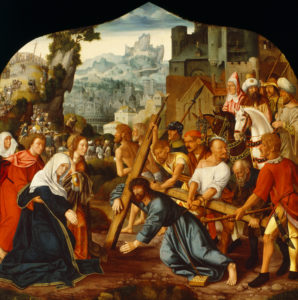Object of the Month: October 2015
Procession to Calvary
Oil on panel
Master of the Holy Blood (Maître du Saint-Sang)
Flemish, active c. 1500
Click on the links throughout the article to view additional artists’ works and reference material.
The identity of the anonymous artist called the Master of the Holy Blood has remained a mystery since the first serious study on the artist by Georges Hulin de Loo in association with the 1902 Exposition de Tableau Flamands des XIVe, XVe et XVIe Siecles in Bruges. De Loo decided to name this anonymous artist after the location of the Lamentation Triptych in the Chapel of the Holy Blood in Bruges, where it has resided since its commission by the Brotherhood of the Holy Blood around 1530.
The general composition of the present Procession to Calvary relates to paintings of the same theme produced in the late fifteenth century, which likely derive from a lost original attributed to Jan van Eyck (best known for the Ghent Altarpiece).
In the upper middle portion of the painting, a Flemish city in the guise of Jerusalem recedes into space through the artist’s use of atmospheric perspective in gray-blue tones. A fantastical building meant to represent the Dome of the Rock rests in the foreground of the city scene while a smaller dome for the Church of the Holy Sepulcher rises on the right side.
Moving from the distant city are progressively closer views of medieval Flemish houses forming a backdrop to the large grouping of figures in the right middle-ground.
Three men on horseback and two soldiers standing behind them form the first figural group of the procession. Each horseman is dressed in oriental garb—a tradition stemming back to the Limbourg Brothers (learn more here) connecting eastern headgear with Jews. The pointed hat on the horseman at the far left is traditionally Jewish in type, whereas the second horseman’s turban has a large jewel on the front associated with Muslim caliphs. The man on the white horse also has a Muslim turban. Northern Renaissance painters used these costuming stereotypes to depict non-Christian characters such as Jews or Arabs. Artists such as the Master of the Holy Blood were not yet exposed to the documented cultures of the Greeks and Romans since such information had not reached the Netherlands in any significant way. Since Islamic culture was also foreign to these artists, any pagan (non-Christian) characters set in Biblical narratives were naively costumed as Muslim.
In the right foreground is a ruggedly dressed soldier armed with both a sword on his hip and a cane for beating Christ. Next to him an elderly man, representing Simon of Cyrene, helps take the weight of the cross from Christ as he falls. His gentle, caring look and effort to support the cross contrast sharply with the tormentors surrounding Christ. The next tormentor, dressed in a white tunic, pulls tight on a rope tied around Christ’s waist to increase His suffering and to prevent Him from resting from the grueling task. The opposite end of the rope falls to Christ’s side and terminates in an unusual object of torture—the spikeblock or stumbling block. Made of a thick plank of wood with nails pierced through, the spikeblock is shown upside down with the nails facing Christ. This unusual object, a Netherlandish invention, maintained a relatively popular appearance (in a variety of forms and types) in northern European art for about 150 years. The concept was intended to visualize the intensity and torture of Christ’s suffering: as Christ made His way to Calvary, the swinging block would wound His heels from behind and His shins from the front, and it would also trip Christ while carrying the cross, thus becoming a “stumbling block.”
The Procession to Calvary is undoubtedly one of the Master of the Holy Blood’s most accomplished works, revealing the trends, motifs, and stylistic hallmarks of an artist who is at once distinctive and also reflective of the influences around him in early sixteenth-century Antwerp and Bruges.
John M. Nolan, Curator
Published in 2015
